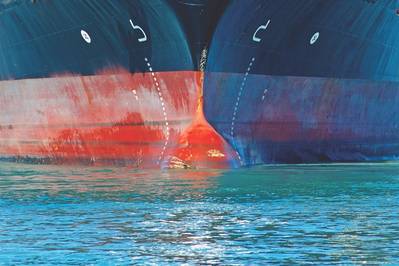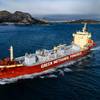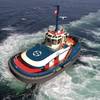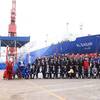The remarkable success of autonomous and remotely-controlled vehicles on land and in the air and the interest in this technology being shown within maritime circles suggests that it is only a matter of time before autonomous ships are deployed at sea.
Although the fuel costs represent, by far, the majority of shipping costs compared to onboard crews, there are yet substantial benefits to be reaped from autonomous ships. The potential economic benefits are too great to ignore this emerging technology.
The success of autonomous shipping will require a complete change in the attitude of those working in the marine environment, starting with shipyards, which are typically focused only on lowering the cost of new ships.
While it is understandable that the current design model strives to minimize the cost of building and operating ships, this often causes less-than-optimal corrosion protection systems to be utilized. This decision-making model focuses on the initial capital expenditure without understanding and considering the significant safety and long term reliability of more advanced system. As a result, we encounter situations where a ship’s crew will apply an additional coat of paint soon after delivery, or shipyards limit warranty coverage, all to compensate for the less-than-optimal corrosion protection systems.
For autonomous shipping to truly work, attitudes and infrastructure must change, beginning with a redesign the world’s shipyards—which is no small task. The success of autonomous shipping will depend upon the concurrent development of many core technologies as well as a commensurate change in behavior and approach to design, construction and operation. Each of the challenges normally faced by mariners on board ships will need to be embodied in the computing systems for autonomous shipping or remotely controlled shipping.
Challenges of Autonomous Shipping
Navigation and communication at sea are challenging. For example, cell phone connectivity breaks down just three miles from shore and communication costs rise dramatically further out at sea.
Autonomous control of a ship’s machinery based on real-time data relating to wind and ocean currents is just one challenge. Additional risks at sea include the unpredictability of the weather and hazardous objects. Safeguarding against piracy, cyber-piracy and terrorism also presents difficult problems as does the reliability of the electronic and mechanical systems of the ship. And lastly, an awareness of the state of corrosion of the ships structures and components is vital.
Autonomous shipping could apply to many types of ships, from tug boats maneuvering in a port to large cargo ships crossing oceans. An autonomous ship must be “aware” of its external surroundings as well as its internal condition. External surroundings include the weather conditions as well as objects at sea that could pose hazards. Internal conditions include the proper functioning of structural elements, engines and machinery as well as the digital computers, along with associated communications and electronics control systems. In this sense, an autonomous ship must be “self-aware.”
Challenges of Maritime Corrosion
The history of maritime industries includes many long chapters on corrosion. The development of seaworthy alloys and coatings was long and arduous, and continues to progress to this day. Today, a large body of knowledge already exists to slow corrosion processes and minimize risks due to corrosion. The failure of critical components at sea can result in the loss of life or the sinking of a vessel; or necessitate costly rescue operations.
The challenge now is to include corrosion prevention in the design and construction of autonomous ships and their onboard sensors and computing systems. This will not be a subtle change and could necessitate a holistic look at how ships are constructed. An autonomous ship cannot depend upon crew members to monitor coating performance and address its maintenance at sea. A ship that has not been maintained, coating-wise, for six months will deteriorate dramatically. Ships must be built to a higher standard of corrosion resistance at every level before they are commissioned. Once in the water, they must be regularly inspected and monitored and held to a higher standard than a manned vessel. Otherwise the failure of a relatively minor part that normally would be repaired at sea could result in a costly rescue operation to recover a vessel stranded at sea.
We are now learning the downstream effects of Tier II engine modifications, including increased cold corrosion in long stroke and more efficient engines. New issues may come into play with Tier III engines, which could include complex additions such as Exhaust Gas Recirculation (EGR), Selective Catalytic Reduction (SCR) and even scrubbers. The Ballast Water Treatment Systems (BWTS) imposed on shipping, as developed in the past decade, are proving to be quite maintenance intensive and would require people onboard.
The fuel situation through 2020 is already uncertain, and beyond 2020 it is even more so. The one certainty is that each major change will have downstream consequences.
Fortunately, corrosion is better understood today compared to the past. Unfortunately, such knowledge is generally not employed; at best, corrosion control is not applied as effectively as it could be, considering the excess focus on construction costs rather than long-term viability and corrosion protection.
Many superior products and solutions on the market today are not used because they are not easily adjusted into the cost-focused construction process. The financial cost of the vessel is the second most important cost in shipping behind fuel costs. Sophisticated corrosion prevention solutions drive up costs, and these added costs could become higher than the cost of crew members.
New alloys and coatings now exist that greatly extend the useful life of components, particularly at sea. Improved methods for monitoring corrosion can be employed. While corrosion cannot be eliminated completely, it can be managed to such a degree that catastrophic failures decrease.
The need to further minimize maritime corrosion on autonomous ships can be taken as an opportunity to improve systems for monitoring and controlling maritime corrosion. This article briefly reviews a few of the ways that current knowledge of maritime corrosion can be adopted in the development of autonomous shipping.
Corrosion of Structural Elements
The trend towards autonomous vessels will have consequences for the management of corrosion. Maritime corrosion is a subject that requires aggressive, proactive measures. Special alloys, coatings and sacrificial anodes have been developed to slow down the inevitable deterioration of materials that occurs in salt water environments. It is rarely a question of “if” but more often a question of “when.” Furthermore, corrosion can be unpredictable and catastrophic. Risk can be controlled but it is not easily eliminated.
Ships are operated in a brutally corrosive environment, with ship hulls especially prone to corrosion. The biofouling of the hulls can contribute to drag and add to fuel costs. Ships carrying freight on long voyages need reliable, long lasting coatings.
The days when ships were free to overlook the issue of corrosion are gone. Ballast and cargo tanks need to be coated. This is a class requirement. If these coatings are not “good” according to the class, the ship cannot trade.
There are several approaches to managing corrosion of a ship’s hull. Most of these involve predicting the time to failure. The ship’s hull itself can be made of special materials selected for their corrosion resistance, although, practically speaking, no material is completely safe from marine corrosion. That said, composites – such as glass flake epoxy – provide excellent corrosion resistance. This underutilized technology – suitable for use in hand rails, ladders, pipe supports and cable trays – has been available for more than 20 years, but resistance to change is strong in the ship building community.
For autonomous shipping, monitoring the condition of the hull is especially important, as daily monitoring by the crew and the potential for early intervention will be nonexistent. The use of unmanned aerial systems for surveys may not be practical when launched from the autonomous vessel itself with no crew aboard. Autonomous underwater vehicles and remotely operated vehicles possess unique capabilities that could be developed for inspecting ship hulls at sea. The key here is the prediction of the time to failure or the detection of a potentially catastrophic condition that would require bringing the ship into a port for emergency repair.
Another solution is to embed sensors within the hull, such as stress sensors or ultrasonic measuring instruments. The processing of such signals can indicate a condition of biofouling or rusting; or even a combination of both.
As is usually the case, there are tradeoffs between the costs for monitoring and maintaining the hull. Risk management will require a corrosion expert to evaluate the data. This knowledge could be built into the autonomous ship’s knowledge base, or judgment calls can be made by a corrosion expert who is remotely monitoring the ship’s condition.
Risk management could affect the size of the vessel; it may be more practical to carry cargo on many small ships and so distribute the risk.
Monitoring and Repair Capability
Typically, it will be necessary to remotely monitor the corrosion of critical control systems on autonomous vessels. Such systems include the propulsion equipment, as well as vital flooding and fire protection systems. These can be monitored in the manner of equivalent systems on an airliner. The main difference is that autonomous ships are at sea and hence they are subject to highly corrosive environments for long periods of time.
Depending upon the type of vessel and length of time at sea, it may be necessary to monitor these components remotely. This can be accomplished by various methods. Sensors can be installed on critical components to monitor their condition at sea and this data can be captured and made available to the computing system used for autonomous control of the ship. This situation is not much different from that of an airliner which may be required to make unscheduled landings when an engine or other critical component fails.
The main difference between an airline and an ocean vessel is that a ship may be at sea for weeks. If a critical component is susceptible to suddenly accelerated levels of corrosion then monitoring of that component may be warranted and the ship must be prepared to change its course for needed repairs. The inability to make repairs on an autonomous ship while it’s underway could induce lengthier in-port periods.
Conclusion
As technologies in support of autonomous shipping mature, the systems for monitoring corrosion will have to become more sophisticated. The removal of the human element from corrosion control can be seen as an opportunity to advance the science of corrosion. Rather than viewing corrosion as a barrier to autonomous shipping, the development of autonomous shipping and on-board data collection could be seen as a means to advance the science of maritime corrosion.
















